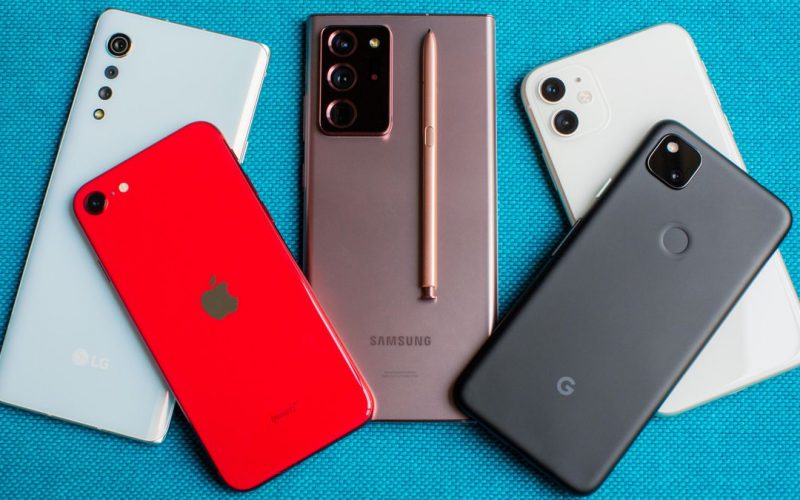It’s hardly an exaggeration to claim that the average individual of today would feel unfinished without his or her smartphone. The use of a mobile phone is now as essential as breathing for most people. There are many hip manufacturers on the market nowadays, each with a variety of excellent mobile phones to suit any budget. In 2023, choosing the top cell phone companies will be a daunting task. This is because there is intense rivalry between these businesses. When it comes to mobile phone providers, the days of having few options are long gone. There are currently a plethora of excellent mobile phone manufacturers all around the world. Fans of cutting-edge technology all across the globe keep guessing who will be the top cell phone provider in 2023. Here is a list of the top ten mobile phone providers around the globe as of 2023.
Top 10 Cell Phone Companies in 2023
It is important to remember that there is no way to determine a single mobile phone manufacturer as the best globally. The top 10 cell phone companies in the world are listed below. The list will give you an idea of which international phone service is the finest after reading it.
#1. SAMSUNG
Samsung is a household name in the mobile industry and has quickly become one of the most recognizable cell phone companies worldwide. The business was established on March 1, 1938, in South Korea. The high quality of the services offered by the corporation and the durability of its cell phones have made it a household name among other cell phone companies around the globe. This company’s smartphones have many advantages over competitors, including their user-friendliness, software innovation, customer service, affordability, etc.
The company’s cellphones are the best-selling cellphones in the world because of the plethora of features and services they offer. Samsung Galaxy A51, Samsung Galaxy S20 Ultra, Samsung Galaxy S20, Samsung Galaxy S10e, Samsung Galaxy S10 Plus, Samsung Galaxy Z Flip, Samsung Galaxy Note 10, Samsung Galaxy Note 10 Plus, Samsung Galaxy S9, Samsung Galaxy S9 Plus, Samsung Galaxy Note 8, Samsung Galaxy Fold, Samsung Galaxy Fold 2, Samsung Galaxy M31, Samsung Galaxy M21, Samsung Galaxy Note 10 Lite, Samsung Galaxy A71, Samsung G80, and Samsung G85 are some of the highest- and best-selling and popular cell phones of within their many companies.
With annual sales of 321.3 million units and annual revenue of 211.2 billion USD, it is the most successful cellphone brand in the world.
#2. APPLE
It is widely recognized as a top-tier mobile phone manufacturer. It is one of the largest technology businesses in the world, and it is headquartered in the United States. On April 1, 1976, Steve Jobs, Steve Wozniak, and Ronald Wayne launched the company. Apple’s iPhone 11, iPhone 11 Pro, iPhone X, iPhone XS Max, iPhone XR, iPhone 8, iPhone 8 Plus, and iPhone SE are among the company’s best smartphones.
It is ranked second due to annual sales of over 217 million handsets and annual revenue of USD 53.8 billion.
#3. HUAWEI
It’s a globally recognized smartphone manufacturer. Founded by Ren Zhengfei in 1987, it is a Chinese global corporation. The Huawei P30 Pro, Huawei Mate 20 Pro, Huawei P30, etc., are just a few of the company’s recent, successful smartphone releases.
Its annual revenue of $8397.01 million and its sales of $107.13 billion place it third on the list.
#4. XIAOMI
In April 2010, Lei Jun launched this Chinese global corporation. Only a few years after its debut, it already poses a serious threat to the market leaders. It ranks as the fourth most valuable tech startup in the world. Mi 10 Ultra, Redmi Note 9 Pro, Redmi 9, Redmi 8, Poco F2 Pro, and Redmi Note 8 Pro are just a few of the company’s popular cellphones.
Fourth on the list is based on annual sales of $119 million and annual revenue of $25.4 billion.
#5. OPPO
OPPO, short for Guangdong OPPO Mobile Telecommunication Corp., Ltd, was founded in 2001 by Tony Chen in China. The OPPO A31, OPPO F15, OPPO A5, OPPO F9, OPPO A9, OPPO Reno2, OPPO F3, F5, F7, F11 Pro, F5 Youth, and OPPO A83 are just a few of the company’s most successful cellphones to date.
With annual sales of 29 million copies and annual revenue of $137.7 million, it ranks #5 on the list.
#6. VIVO
Shen Wei started the Chinese IT firm VIVO Communication Technology Co. Ltd. in 2009. A variety of high-quality Vivo cell phones are available. The business has released a number of successful smartphones, including the Vivo V17 Pro, VIVO Z1x, VIVO S1 Pro, VIVO S1, Vivo V17, VIVOZ1 Pro, VIVO S1, Vivo U20, Vivo U10, Vivo V15, and Vivo Y11.
With annual sales of 49.5 million units and annual revenue of $46 million, it ranks no. 6 on the list.
#7. MOTOROLA
American telecom giant founded in 1928 by brothers Paul and Joseph Galvin. From 2007-2009, the company lost $4.3 billion. In 2011, Motorola was split into Motorola Mobility and Motorola Solutions, two separate public corporations. The Motorola Razr, Mate X, MOTO G8 Plus, MOTO Z4, MOTO One Action, MOTO Z3, MOTO G7 Power, MOTO G7 Plus, and Motorola One Vision are just a few of the company’s most successful mobile phones.
With annual sales of $12 million and annual revenue of $7.4 billion USD, it ranks #7 on the list.
#8. LENOVO
On November 1, 1984, Liu Chuanzhi launched the international corporation LENOVO in Hong Kong. Lenovo’s newly released smartphones are the greatest in both price and performance. Lenovo has released a number of cell phones, including the Z5, the K5 Note, the P2, the Z2 Plus, the K6 Power, the Vibe k5, the Vibe k5 Note, the Z5s, and the Z5 Pro GT.
With annual sales of 35 million units and annual revenue of $14 billion, it ranks eighth on the list.
#9. LG
Koo-In-hwoi established LG Electronics as a multi-national corporation in South Korea in 1958. The LG G7 Plus ThinkQ, LG W10 Alpha, LG V30 Plus, LG Stylo 5, LG Q70, and LGK61 are some of the company’s most recent and successful smartphone releases. LG’s smartphone offerings were not widely well-received upon their release.
With an annual revenue of $54.9 billion, it ranks #9 on the list.
#10. NOKIA
On May 12, 1865, Fredrik Idestam, Leo Mechelin, and Eduard Finland created the international corporation Nokia. Nokia formerly dominated the mobile market, but as technology advanced and smartphones were launched, the company was left behind. Now, Nokia is trying to make a comeback by selling smartphones. Nokia has released a number of successful smartphones, including the Nokia 2.3, Nokia 220, Nokia 110, Nokia 6.2, Nokia 3.2, Nokia 9 Pureview, Nokia 8.1, etc.
Its annual sales of more than 17.5 million handsets place it at number 10 on the list of smartphone manufacturers.
What Is the Most Reliable Phone Brand?
#1. Google – 7.14 / 10
The Google Pixel is the most trustworthy cellphone on the market. The primary reason for this is that they have a longer warranty than other brands like Apple and Samsung. Despite being tied with Samsung in terms of camera value, Pixels continue to score highest in battery life and evaluations.
#2. Samsung & Apple – 3.57 / 10
With a 3.57 average, both Samsung and Apple tied for second place, behind Google. In three metrics, both brands performed better than the other. Models like the Galaxy S22 Ultra contribute to Samsung’s smartphones’ longer battery life, greater refresh rates, and superior camera quality. However, Apple’s iPhones came out on top when it came to being resistant to water, having high processor scores, and having generally positive reviews. Apple only provides a one-year guarantee, but its in-store after-service is excellent, including both hardware and software support.
What Are the Best Phones in the World
- Samsung Galaxy S22+ (Android) 128 GB
- Samsung Galaxy S23 Ultra 256 GB
- OnePlus 11 5G (2023) 256 GB
- Samsung Galaxy S22 Ultra 128 GB
- Samsung Galaxy S22 Ultra 512 GB
- OnePlus 10T (2022) 128 GB
- Apple iPhone 12 64 GB
- Apple iPhone 12 128 GB
What Makes the Best Phones
This feature list will teach you what to look for in your cell phone and where to find it.
#1. Screen Size
Back in the day of flip phones, it wasn’t necessary to have a large phone. In addition, talking and texting were the two most common uses for cell phones. Those cheap 2D visuals didn’t help matters any, though. Therefore, a bigger screen appeared more of a nuisance than an asset. But with the introduction of cell phones, that all started to alter, and companies have to make adjustments. The public was awestruck when the first 4.0 and 4.3-inch waves appeared in late 2009 and early 2010. Since then, it’s been very evident that a whimsical 3.5-inch screen or smaller is no longer adequate. How big should it be? Phones with 4.0 and 5.0 inches displays are optimal because they provide the best balance of portability and power. For instance, cell phones in this class tend to be smaller and lighter, making them easier to carry around in a pocket.
#2. Screen Resolution and Quality
Companies clearly place a premium on the display of their cell phones, as evidenced by the iPhone’s retina display and HTC’s Super LCD panels. The screen’s display is immediately visible upon powering it on. This means that screen quality is just as important to manufacturers as screen size. Resolution and display technology are two of the most important aspects of a good display.
#3. Camera
Photos can forever immortalize both precious and mortifying memories, depending on the user’s perspective. Choosing the best camera phone is becoming increasingly crucial as more people abandon point-and-shoot cameras in favor of smartphones. With so many options, it can be challenging to find the best camera phone among today’s smartphones.
Therefore, you can’t judge a phone’s camera quality by its specifications alone. Don’t bother asking a sales representative, as they will likely boast about how great the phone’s camera is, while never having used it. The best approach to evaluate a smartphone’s camera is to examine sample photographs and videos taken with the device.
#4. Battery Life
The world’s fastest car is yours for the taking. If the gas tank is empty, it is useless. Similarly, a top smartphone with a weak battery is useless. A phone should have a battery life of at least a day with average use. Make sure the smartphone you choose has a battery capacity of at least 2000 mAh and a minimum talk duration of 15 hours. A cell phone with these specifications should have a battery life of at least a day.
#5. Memory (RAM) And Processing Power
When you hear the breathtaking sound of a powerful engine throttling, your heart probably jumps in wonder. In a similar vein, the incredible variety of high-powered and capacious smartphones available today has smartphone fans in awe. Manufacturers continue to increase the storage capacity and number of processor cores in smartphones every year. Is it essential to have that much control?—Absolutely not. In truth, the most recent iPhones have mid-range specifications compared to Android flagships. Yes, having a lot of RAM and computing power is not crucial.
#6. Storage
Storage is gradually becoming an essential feature as people stop caring about MP3 players, point-and-shoot cameras, and portable video cameras. Furthermore, there is a substantial cost difference between various tiers of storage. The 16 GB version of the iPhone 5S initially retailed for $649, while the 32 GB version was $749, a huge price gap of $100. The most economical choice would be the one that requires a minimum amount of storage space.
#7. Accessories
Accessories, while not the most remarkable aspects of cell phones, have their uses. The Galaxy Note series, for instance, gains a lot of extra features thanks to the S-Pen. However, the essentials—USB charger, screen protector (occasionally), and headphones—come standard with most smartphones. Adaptor support is the primary consideration.
Why Apple Is Better Than Android
Here are some of Apple’s advantages over Android:
#1. Better Performance
Apple phones are superior when compared to Android handsets. They’re made to run more quickly and efficiently. The older iPhones still run smoothly and reliably.
iPhones feel like magical illustrations due to their tremendous internal storage. They have far more memory on the inside and rarely freeze, guaranteeing faultless operation.
In addition, Apple is fine-tuned to work perfectly within the constraints of its hardware. Android devices, unlike iPhones, are optimized by original equipment manufacturers (OEM), which may occasionally do a subpar job.
#2. Easy to Use
The iPhone’s user-friendliness is another area where it excels above Android. The iPhone’s intuitive design makes it straightforward to reach your desired destination.
The limited customization options on iOS are an advantage over Android. Even first-time iPhone users quickly get the hang of things. The iPhone’s intuitive user interface also helps users become accustomed to it.
iOS devices’ home screens display app icons in standard rows and columns. The data is readily available for the user to rearrange the columns as needed. The preferences are very easy to understand and use, providing an identical encounter every time.
#3. Timely OS Update
The iPhone has an advantage over Android in that it provides updates more quickly and automatically to its customers. The designers at Apple are very aware of their products’ capabilities. When an update is available for iOS, users are prompted to download and install it.
Every user will be able to take advantage of the new enhancements as soon as the update becomes life for their device. However, the latest upgrades may not be available for older Apple devices. Notwithstanding, it will continue to operate normally.
Android, on the other hand, releases updates at their own discretion and independently of Google.
#4. Security and Privacy
The privacy and security features of the iPhone are well-known. It has multiple identification methods, such as fingerprint and facial recognition.
Apple also prevents apps from collecting personal information and logging your location. iPhones also have end-to-end encryption for iMessage and FaceTime video calls.
Apple’s consumers are safe from viruses and malware thanks to the company’s innovative software and cutting-edge technology.
#5. Third-party App Security
Apple tests each product it sells for safety and quality flaws before releasing it to the public. This is why all iOS devices may provide consumers with protection against malicious apps.
The Apple App Store is very particular about the apps it accepts. Therefore, customers can have confidence that the app they have downloaded is safe and secure.
#6. No Bloatware
Do you want to know why Apple’s iOS is superior to Google’s Android? There is no unnecessary extra software included. When compared to Android, the iPhone’s superior performance can be attributed to its fewer pre-installed apps.
In addition, iPhone owners can improve their experience by erasing bloatware. However, pre-installed apps on Android devices cannot be deleted.
An iPhone’s intentions are crystal obvious; the device does not ship with any malicious software designed to steal your personal information.
#7. Family Sharing
The iPhone is superior to the Android because of the Family Sharing function.
The iPhone simplifies content sharing within families thanks to its family-sharing features. In reality, you may use the family sharing function to buy and sync content on numerous iOS gadgets and Apple IDs.
Then what? The good news is that most parents sanction family sharing. This means there is no way for commercials or illicit material to be downloaded by children.
#8. The Apple Ecosystem
With the help of AirPods, Apple Watch, HomePods, Apple TV, Mac, and iPhone, you can set up a fully functional Apple environment. You may switch between devices without any hassle. Using the Apple ecosystem is made possible by the software and hardware included in Apple products.
No other brand or ecosystem can compare to Apple when it comes to providing an effortless user experience.
Conclusion
So, to wrap things up, that was our take on the top cell phone companies right now. The cellphone sector is very competitive, with manufacturers constantly striving to outdo one another with innovative new features. Now more than ever, with the present pandemic condition of COVID-19 forcing practically all students to migrate to an online method of instruction, cell phones are an absolute requirement, and mobile phone companies are in a fierce battle to establish their worth.
Related Articles
- SMARTPHONE BRANDS: Best, Cheapest & World List of Smartphones
- BUSINESS CELL PHONES: Reviews and Best Cell Phone List for Business Owners (Updated)
- MAKE MONEY FROM YOUR PHONE: Free Tips.
- SAMSUNG INSURANCE: Samsung Care+ Features, Benefits, And Cost
- PHONE BRANDS: Top Phone Brands






